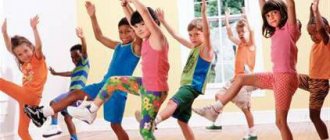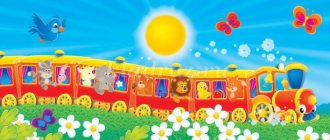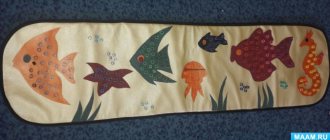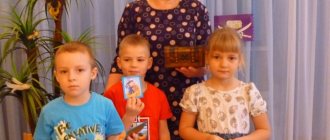MAGAZINE Preschooler.RF
“Formation of motor activity of preschool children through story-based physical education classes”(experience)
Municipal preschool educational institution "Kindergarten No. 33" in Tver.
EDUCATIONAL AREA “PHYSICAL DEVELOPMENT”
Completed by: Svetlana Anatolyevna Starkova, physical education instructor, highest qualification category, Municipal Preschool Educational Institution “Kindergarten No. 33”, Tver
Relevance
I consider the topic I have chosen to be relevant, since basically educational activities in physical education in kindergarten are monotonous. Therefore, I, like all teachers of preschool institutions, began to look for new ways to increase the effectiveness of physical education classes, including in the content such educational material that would contribute to the diversified development of the child, bring him joy, satisfy the natural need for movement, and promote health. One of these ways is to use various forms of physical education classes when working with children. In order for physical education classes to be truly developmental, health-improving, interesting, exciting and educational, in my work I use different forms of their implementation, depending on the age, the goals set, the location and conditions. Most often when working with children I use story-based activities.
In this work I will try to show the importance of story-based physical education classes and their correct organization.
Problem
I was faced with a pedagogical problem: how to strengthen and improve children’s health within a kindergarten, by what means to increase children’s interest in physical education and creativity in physical activity. Based on the importance of this problem, a hypothesis was put forward.
Hypothesis
If you correctly plan educational activities in physical education for preschool children of a preschool educational institution, this will help to most fully satisfy the children’s need for physical activity, increase interest in physical education, and solve the problem of mastering basic types of movement and developing physical skills and abilities.
Goal and tasks:
Goal: Find ways to develop motor activity in preschoolers through story-based physical education classes; study and plan story-based physical education activities as a means of developing the educational, educational, and health potential of preschool children.
Tasks: 1) Study the literature on the topic. 2) Plan the type of activity. 3) To highlight the features of the development of interest in movements in preschool children in the process of story-based physical education classes. 4) Choose the most optimal methods and techniques in your work. 5) Create conditions in preschool educational institutions for conducting subject-based physical education classes. 6) Provide methodological recommendations for developing interest in movements in preschoolers through story-based physical education classes. 7) Evoke an emotional response in children and their parents, a desire to participate in the process. To ensure the interrelation of plot-based physical education classes with other types of activities in a single pedagogical process.
2) Plan the type of activity. 3) To highlight the features of the development of interest in movements in preschool children in the process of story-based physical education classes. 4) Choose the most optimal methods and techniques in your work. 5) Create conditions in preschool educational institutions for conducting subject-based physical education classes. 6) Provide methodological recommendations for developing interest in movements in preschoolers through story-based physical education classes. 7) Evoke an emotional response in children and their parents, a desire to participate in the process. To ensure the interrelation of plot-based physical education classes with other types of activities in a single pedagogical process.
Characteristics of the concept of “story-based physical education activities”
“Story-based classes” is one of the organizational forms of conducting physical education classes, which helps to develop interest in the process of performing physical exercises and basic types of movements in preschool children.
Using story-based activities helps in solving the following problems:
— consolidate and improve children’s motor skills in a playful way;
- develop mental abilities and emotional sphere;
— develop children’s musical and rhythmic abilities;
- cultivate interest and need for systematic physical exercise;
- educate and develop children's creative abilities, imagination, fantasy;
— to promote interest in improvising various actions during the lesson.
Structure of subject-based physical education classes
When planning story activities, you should consider the following factors:
- Plot-shaped physical education classes. Goal: through a familiar imitative image, to attract children to perform a variety of movements, acquiring a variety of motor skills. (Throughout the entire lesson, different movements have different images or one image is embodied in different movements).
- Game-based physical education classes. Goal: to teach children to set a task and solve it, overcoming various problematic situations, cultivating in themselves the psychological and physical qualities necessary for this.
- Thematic and thematic physical education classes. Goal: to teach children to overcome motor difficulties, navigate problem situations, develop creativity, fantasy and imagination in children
The plot lesson notes are aimed at solving the following problems:
— strengthening children's health;
— increasing the functional and adaptive capabilities of the body, mental and physical performance;
— harmonious development of all parts of the musculoskeletal system, formation of correct posture;
— improvement of motor skills, development of motor qualities;
— development of mental abilities and emotional sphere;
— development of musical and rhythmic abilities, imitative movements;
- nurturing interest and need for systematic physical exercise;
- formation of habits for a healthy lifestyle.
Methodological recommendations for conducting plot-based physical education classes.
When guiding motor activity, the teacher needs to develop the personal interests and initiative of children.
The child should be encouraged to perform the movements independently; ready-made models should not be abused.
When performing a motor task in a plot form, it is useful for children to be masters of the situation.
During classes, it is important to maintain the correct rhythm, because... For a preschooler, loss of movement can lead to loss of health.
Creating conditions for creativity and the predominance of positive emotions in physical education classes stimulates the child’s motor activity.
It is very important to create optimal conditions for each child, in the process of performing movements, to develop the imagination of mastering motor actions.
Use options for combining several types of movements to expand children's motor experience.
As you perform the actions, evaluate each child.
Use different types of plot-based physical education classes (based on literary works, with one plot, with one image, plot-based classes that combine an environmental focus).
Use plot-based activities and role-playing games in your work.
Include techniques with an imaginary situation in classes to enhance initiative and successful actions.
M O N I T O R I N G
children's achievements of the results of mastering the program in the direction of "Physical development" at the preschool educational institution "Kindergarten No. 33"
Purpose: examination of the physical condition of both an individual child and the group as a whole in a preschool educational institution. Objectives: To identify the level of physical development, physical fitness and performance of children. Implement an individually differentiated approach to the physical education of children. Organize data recording and information collection.
A high level of mastery of the program in children who show a strong interest in physical exercises and basic movements. They exercise elements of control over the actions of peers, notice violations of the rules in games and exercises. These children experience a transfer of mastered movements and exercises into independent activities.
The average level of mastery of the program is for children who master the main elements of the technique of most movements. Able to independently perform exercises and movements based on preliminary demonstration. Sometimes they notice mistakes when doing exercises and violations of rules in games. They are very passionate about the process, but do not always pay attention to the result. Active in games.
Low level of program mastery among children who make significant errors in movement technique. They do not comply with the given pace and rhythm, they act in accompaniment of the teacher’s demonstration. They break the rules in games, although they participate in them with interest. They do not notice mistakes in the actions of others.
Comparative analysis of the level of physical development and children’s achievements in the results of mastering the program in the direction of “Physical Development” in the preschool educational institution “Kindergarten No. 33”
conclusion
Physical education classes in kindergarten are designed to satisfy the biological need of the growing body for physical activity, to give the child the opportunity to feel the joy and pleasure of being able to control his body. Therefore, well-prepared story-based physical education classes greatly contribute to the physical and mental development of children, as they provide optimal conditions for the normal functioning of the nervous system, which in turn helps better perception and memory. Children develop positive emotions that create a cheerful, cheerful mood, and also develop the ability to quickly overcome a negative mental state. This is necessary because positive emotions have a beneficial effect on the functioning of all organs and systems of the body, ensuring the speed and strength of the formation of motor skills and abilities.
In story-based classes, children develop a positive attitude towards physical exercise, enrich their motor experience, and develop the ability to perform familiar movements easily and freely, rhythmically and consistently, orienting themselves in space and maintaining balance. Develops agility, speed, and ingenuity. In story-based classes, children improve coordination of movements, balance, and monitor the position of their body in a variety of exercises. Children try to maintain certain intervals while moving in different formations and navigate in space.
Thus, the plot-based and playful form of physical education classes helps me develop initiative and independence in children, creates conditions for repeated performance and increasing interest in movement. Movements associated with some image or plot captivate children; the image encourages them to perform imitative movements, which preschoolers really love. Movements, even the simplest ones, provide food for children’s imagination, develop creativity, which is the highest component in the structure of the personality, and represents one of the most meaningful forms of a child’s mental activity. The children learn to think and act at the same time. In addition, in the process of story-based physical education classes, children develop self-esteem: the child evaluates his “I” by the direct efforts he made to achieve his goal. In connection with the development of self-esteem, personal qualities develop: self-respect, conscience, pride.
As a result of the joint efforts of teachers and parents, we see positive results in the emotional and motor lives of children. Many children became sociable, sociable, spontaneous, coordination of movements and expressiveness improved, children began to feel more confident in children's entertainment, leisure, and sports competitions; children developed a sense of rhythm, imagination, and the ability to transform.
List of used literature
| Next > |
Thematic physical education classes with children in a preschool educational institution.
Thematic physical education classes with children in a preschool educational institution.
Modern preschool educational institutions use different forms of physical education classes. One of these forms is subject-based physical education classes. Story-based physical education classes help preschoolers develop learning skills in a fun way. They teach children to remember the plan of action and be guided by it while performing physical exercises in a playful way. They develop value judgments in children: achieving good results in front of all children instills confidence in the child and creates a joyful mood, awareness of their abilities and capabilities in realizing common interests, and shared joy is double joy.
Successful solution of educational problems is possible only if the requirements for the health-improving orientation of thematic physical education classes are met. Ensuring high physical activity of children during story-based activities, observing scientifically based loads on all organs and systems of the child can ensure an effect in his physical development and health promotion.
Specially organized subject-based physical education classes with the entire group ensure the passage and mastery of program material in a certain sequence; allow, as necessary, to repeat and consolidate motor actions. Training is carried out systematically. Classes are built according to a specific plot plan and therefore allow you to dose the physiological load, gradually and carefully increasing it, which helps to increase the body's endurance. Preparing the body to perform complex movements helps prevent injuries when performing them.
The plot lesson includes elements of walking and running in the introductory part of the lesson, general developmental exercises with and without objects, basic movements, outdoor and sports games in the main part, breathing exercises, finger games and low-intensity games in the final part. Classes of this nature are distinguished by interesting content, games, a joyful atmosphere, positive children's emotions and beautiful figurative speech of an adult.
Using story-based activities helps in solving the following problems:
- consolidate and improve children’s motor skills in a playful way;
- development of mental abilities and emotional sphere;
- development of musical and rhythmic abilities,
- nurturing interest and need for systematic physical exercise.
- educate and develop children's creative abilities and imagination
- promote interest in improvising various actions during the lesson.
All plot activities can be divided:
1. Plot-based physical education classes.
Goal: Acquisition of a variety of motor skills through
imitative image.
Throughout the lesson, different movements have different images or one image is embodied in different movements. These can be “bunnies”, “bear cubs”, “puppies”
2. Game-based physical education classes.
Goal: Overcoming various problematic situations, cultivate physical and psychological qualities. Teach children to set a goal and achieve it a). Through the game “Visiting Grandma” or “Driving along the Road,” children learn to overcome game obstacles in performing movements, spatial orientation, etc.
b) Through a story game with a specific purpose, for example, “Let's help the animals wake up the sun,” children are initially given a goal, to achieve which it is necessary to overcome motor difficulties and be able to resolve a problem situation.
3. Thematic and thematic physical education classes.
Plot-thematic classes, in turn, can be divided into three types:
- Thematic and thematic physical education lesson on fairy tales and literary works.
The purpose of such classes is to teach how to navigate problem situations, to develop creativity, fantasy and imagination in children; overcome motor difficulties,
a) The lesson can be based on the plot of one fairy tale, literary work, for example “Geese and Swans”, “Kolobok”, “Wolf and Little Goats”
b) The lesson is based on a meeting with characters from different fairy tales, for example, “Journey to the Land of Fairy Tales.”
c) Throughout the entire lesson, there is one fairy-tale character, for example, Carlson, Pinocchio, Doctor Aibolit.
- Thematic and thematic physical education activities related to seasonal phenomena in nature and social life.
These classes contribute to the cognitive development of schoolchildren and create excellent conditions for improving basic movements; stimulate motor activity, regulate it, thus ensuring the harmonious development of the child.
Cognitive development of preschoolers is carried out unobtrusively, through play. Preschoolers will learn about the peculiarities of natural phenomena. Thus, in the lesson “Journey to the Autumn Forest,” children will learn that the squirrel makes provisions for the winter (nuts, mushrooms), and the hedgehog is preparing for hibernation. In the classes “Walk in the Autumn Forest”, “Spring Has Come”, children learn that the bear is a forest animal. He goes to sleep in a den in the fall until spring. In the lesson “Bear-athlete” - that the bear is strong, can climb trees, run, swim.
Activities such as “Sailors”, “Postman”, “We are athletes”, “Circus” help children consolidate their knowledge about the work of adults and the phenomena of social life.
- Thematic and thematic physical education classes with one manual.
In classes, children will learn about the variety of ways to use any sports aid in various types of motor activity (jumping, throwing, balance, running).
The purpose of such classes is:
-Development of motor skills and abilities; physical qualities.
— Children learn to use the same object in different situations[5]. Preschoolers fantasize and come up with various exercises, which contributes to the development of imagination, self-expression, and creative activity.
Classes with one manual are used in all age groups; they are aimed at training and consolidating movements. These could be activities such as “Multi-colored ball”, “Magic hoop”, “Magic wand”, “Ladder”, “Magic jump rope”.
Classes with non-standard sticks are very interesting, which include the following types of activities: drill exercises (different types of walking with a stick; walking and running with stepping over sticks; running with jumping over a stick); general developmental exercises; laying out a path of sticks and walking and running along this path, jumping over it; active play with sticks, exercises for developing fine motor skills of the hands - massage, laying out various objects from sticks (a circle, a house, the sun, a car, etc.)
The use of imitation and imitation techniques facilitates the process of memorization, mastering exercises, increases the emotional background of the lesson, promotes the development of thinking, imagination, creative abilities, and cognitive activity.
Movements associated with some image or plot captivate children; the image encourages them to perform imitative movements, which preschoolers really love. Different roles for children mean different motor tasks. For example, children - “mice” - look out of their holes, walk with small steps, children - “kittens” - arch their backs, catch their tails, play with a ball, while the “mice”, scared, watch them. Children in the role of bunnies learn to jump, in the role of athletes they learn to exercise with a stick, in the role of sailors they learn to “walk and crawl on a high and slippery deck.
Such activities develop children's creativity, fantasy, and imagination. Literary heroes teach children to overcome motor difficulties in achieving goals and navigate problematic situations. This type of activity is valuable because children reveal themselves in unexpected ways, for example: they show artistry, musicality, and independence. This is one of the reasons for conducting story-based physical education classes.
Physical education classes in plot form begin with an emotional story in which an imaginary situation is set, the conditions for accepting the role are revealed to the children, and the sequence of exercises and their content are communicated. In each age group, I try to use a variety of techniques to create play motivation that encourage children to enthusiastically perform physical exercises: these include riddles about animals, about natural phenomena, artistic expression, and magical transformations into different characters; use of toys, masks. When selecting exercises, the age characteristics of children are taken into account, and their level of physical fitness is also taken into account.
The variety of standard and non-standard equipment in the classroom, the presence and use of natural materials contributes to better organization and increased motor activity of children.
Story classes are held 1-2 times a month. The topics of such classes depend on long-term thematic planning in kindergarten. Thus, plot-based physical education classes allow you to independently find the optimal ways to perform basic movements and general developmental exercises; they contribute to the development of physical qualities, the development of creativity, and mental processes.
These classes open up wide opportunities for working with children, create favorable conditions for improving basic movements, promote the mental and physical development of a preschooler, stimulate motor activity, regulate it, thus ensuring the harmonious development of the child.






